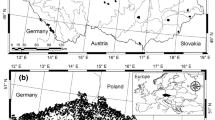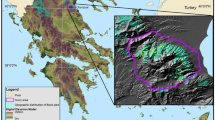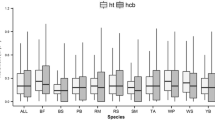Abstract
• Context
Tree height prediction is an important issue in forest management since tree heights are usually measured only in a sample of trees. Although numerous model approaches have been used for this purpose, no agreement on which one is more appropriate has been achieved.
• Aims
To analyse the random effects of basic and generalised height–diameter (h–d) models fitted to multi-species uneven-aged forest stands, and to establish their ability to explain differences between ecoregions, plots and species.
• Methods
Height and diameter measurements for 29,084 trees from 187 sample plots located in the state of Durango (Mexico) were used. Basic and generalised h–d models were fitted in a mixed-models framework. The variability between ecoregions, plots and species was considered in the random effects definition. Model calibration for different height sampling designs and sampling sizes was also analysed.
• Results
Random components performed well in explaining the differences in the h–d relationship between the different plots and species; however, no significant variance for the random effects was found for the different ecoregions. A calibrated basic h–d model produced similar results to a fixed-effects generalised h–d model when a sufficiently large number of trees was used in the calibration process.
• Conclusion
From a practical point of view, if no calibration is carried out, different models should be used for the different species, so that at least the variation among species is captured.






Similar content being viewed by others
References
Akaike H (1974) A new look at the statistical model identification. IEEE T Automat Contr AC-19:716–723
Amaral Paulo J, Tomé J, Tomé M (2011) Nonlinear fixed and random generalized height-diameter models for Portuguese cork oak stand. Ann For Sci 68:295–309
Bailey RL, Brooks JR (1994) Determining site index and estimating timber volumes without measuring heights. South J Appl For 18:15–18
Beal SL, Sheiner LB (1982) Estimating population kinetics. Crit Rev Biomed Eng 8:195–222
Bertalanffy L (1949) Problems of organic growth. Nature 163:156–158
Calama R, Montero G (2004) Interregional nonlinear height–diameter model with random coefficients for stone pine in Spain. Can J Forest Res 34:150–163
Calama R, Montero G (2005) Multilevel linear mixed model for tree diameter increment in stone pine (Pinus pinea): a calibrating approach. Silva Fenn 39:37–54
Camille A, García-López GA (2008) Cross-scale linkages in common-pool resource management: the evolution of forest associations in the Mexican forest commons. Prepared for the 12th IASC 2008 biennial conference. University of Gloucester, Cheltenham
Castedo-Dorado F, Diéguez-Aranda U, Barrio Anta M, Sánchez Rodríguez M, Kv G (2006) A generalized height–diameter model including random components for radiata pine plantations in northwestern Spain. Forest Ecol Manage 229:202–213
Chung Y, Rabe-Hesketh S, Dorie V, Gelman A, Liu J (2013). A nondegenerate penalized likelihood estimator for variance parameters in multilevel models. Psychometrika (in press). doi:10.1007/S11336-013-9328-2
Corral-Rivas JJ, Álvarez-González JG, Ruiz-González AD, Kv G (2004) Compatible height and site index models for five pine species in El Salto, Durango (Mexico). Forest Ecol Manage 201:145–160
Crecente-Campo F, Tomé M, Soares P, Diéguez-Aranda U (2010) A generalized nonlinear mixed-effects height-diameter model for Eucalyptus globulus L. in northwestern Spain. Forest Ecol Manage 259:943–952
Curtis RO (1967) Height–diameter and height–diameter–age equations for second-growth Douglas-fir. Forest Sci 13:365–375
Davidian M, Giltinan D (1993) Some general estimation methods for nonlinear mixed effects models. J Biopharm Stat 3:23–55
Goldstein H (1995) Multilevel statistical models, 2nd edn. Halstead Press, New York, 178 pp
Hall DB, Bailey RL (2001) Modeling and prediction of forest growth variables based on multilevel nonlinear mixed models. Forest Sci 47:311–321
Hartford A, Davidian M (2000) Consequences of misspecifying assumptions in nonlinear mixed effects models. Comput Stat Data Anal 34:139–164
Huang S, Price D, Titus SJ (2000) Development of ecoregion-based height-diameter models for white spruce in boreal forests. Forest Ecol Manage 129:125–141
Jayaraman K, Lappi J (2001) Estimation of height–diameter curves through multilevel models with special reference to even-aged teak stands. Forest Ecol Manage 142:155–162
Kozak A, Kozak R (2003) Does cross validation provide additional information in the evaluation of regression models? Cana J Forest Res 33:976–987
Lappi J (1991) Calibration of height and volume equations with random parameters. Forest Sci 37:781–801
Lappi J (1997) A longitudinal analysis of height/diameter curves. Forest Sci 43:555–570
Lei Y, Parresol BR (2001) Remarks on height-diameter modelling. USDA For. Serv. Research Note SRS-10. Southern Research Station, Asheville
Lindstrom MJ, Bates DM (1990) Nonlinear mixed-effects models for repeated measures data. Biometrics 46:673–687
Littell RC, Milliken GA, Stroup WW, Wolfinger RD, Schabenberger O (2006) SAS® for mixed models, 2nd edn. SAS Institute Inc, Cary
Longford NT (1993) Random coefficient models. Clarendon Press, Oxford, 270 pp
López Sánchez CA, Gorgoso Varela J, Castedo Dorado F, Rojo Alboreca A, Rodríguez Soalleiro R, Alvarez González JG, Sánchez Rodríguez F (2003) A height-diameter model for Pinus radiata D. Don in Galicia (Northwest Spain). Ann Forest Sci 60:237–245
Lynch TB, Holley AG, Stevenson DJ (2005) A random-parameter height−dbh model for cherrybark oak. South J Appl For 29:22–26
Morrison ML, Marcot BG, Mannan RW (1992) Wildlife habitat relationships: concepts and applications. Univ. Wisconsin Press, Madison
Newton PF, Amponsah IG (2007) Comparative evaluation of five height–diameter models developed for black spruce and jack pine stand-types in terms of goodness-of-fit, lack-of-fit and predictive ability. Forest Ecol Manage 247:149–166
Parresol BR (1992) Baldcypress height–diameter equations and their prediction confidence interval. Can J Forest Res 22:1429–1434
Pinheiro JC, Bates DM (2000) Mixed-effects models in S and S-PLUS. Springer Verlag, New York
Richards FJ (1959) A flexible growth function for empirical use. J Exp Bot 10:290–300
SAS Institute Inc (2008) SAS/ETS® 9.2 User’s Guide. SAS Institute Inc, Cary
SAS Institute Inc (2009) SAS/STAT® 9.2 User’s guide, 2nd edn. SAS Institute Inc, Cary
Saunders MR, Wagner RG (2008) Height-diameter models with random coefficients and site variables for tree species in central Maine. Ann For Sci 65:203p1–203p10
Schnute J (1981) A versatile growth model with statistically stable parameters. Can J Fish Aquat Sci 38:1128–1140
Sharma M, Parton J (2007) Height–diameter equations for boreal tree species in Ontario using a mixed-effects modeling approach. Forest Ecol Manage 249:187–198
Sharma M, Zhang SY (2004) Height–diameter models using stand characteristics for Pinus banksiana and Picea mariana. Scand J Forest Res 19:442–451
Soares P, Tomé M (2002) Height–diameter equation for first rotation eucalypt plantations in Portugal. Forest Ecol Manage 166:99–109
SRNyMA (2006) Programa estratégico forestal 2030. Secretaría de recursos naturales y medio ambiente del Estado de Durango. Dgo, Victoria de Durango
Thoms CA, Betters DR (1998) The potencial for ecosytems management in Mexico’s forest ejidos. Forest Ecol Manage 103:149–1179
Trincado G, VanderSchaaf CL, Burkhart HE (2007) Regional mixed-effects height–diameter models for loblolly pine (Pinus taeda L.) plantations. Eur J Forest Res 126:253–262
Vanclay JK (2009) Tree diameter, height and stocking in even-aged forest. Ann For Sci 66:702p1–702-p7
Vargas-Larreta B, Castedo-Dorado F, Álvarez-González JG, Barrio-Anta M, Cruz-Cobos F (2009) A generalized height-diameter model with random coefficients for uneven-aged stands in El Salto, Durango (Mexico). Forestry 82:445–462
Vonesh EF (1996) A note on the use of Laplace’s approximation for nonlinear mixed effects models. Biometrika 82:447–452
Vonesh EF, Chinchilli VM (1997) Linear and nonlinear models for the analysis of repeated measurements. Marcel Dekker Inc, New York
Wehenkel C, Corral-Rivas JJ, Hernández-Díaz JC, Gadow Kv (2011) Estimating balanced structure areas in multi-species forests on the Sierra Madre Occidental, Mexico. Ann For Sci 68:385–394
West PW, Ratkowsky DA, Davis AW (1984) Problems of hypothesis testing of regressions with multiple measurements from individual sampling units. Forest Ecol Manage 7:207–224
Yang RC, Kozak A, Smith JH (1978) The potential of Weibull-type functions as a flexible growth curve. Can J Forest Res 8:424–431
Zhang L (1997) Cross-validation of nonlinear growth functions for modeling tree height-diameter distributions. Ann Bot 79:251–257
Zhang SA, Burkhart HE, Amateis RL (1997) The influence of thinning on tree height and diameter relationships in loblolly pine plantations. South J of Appl For 21:199–205
Funding
Fondo Sectorial CONAFOR-CONACYT (Project CONAFOR-CONACYT 115900) (México); Fondo de Cooperación Internacional en Ciencia y Tecnología Unión Europea-México (Project FONCICYT-92739). Consellería de Economía e Industria (Galicia, Spain).
Author information
Authors and Affiliations
Corresponding author
Additional information
Handling Editor: Barry Alan Gardiner
Contribution of the co-authors
Felipe Crecente-Campo: analysing data, writing the manuscript.
José Javier Corral-Rivas: designing the experiment, field data collection, supervising the work, coordinating the research project.
Benedicto Vargas-Larreta: designing the experiment, field data collection, supervising the work.
Christian Wehenkel: designing the experiment, field data collection, supervising the work.
Appendix. Height estimation—an example
Appendix. Height estimation—an example
This Appendix shows an example of the height estimation using the calibrated Eqs. 9 and 11. Equations 10 and 12 should be calibrated in the same way as Eqs. 9 and 11, respectively.
We suppose that the following data belong to three new plots in which several species are present, but we are interested in calibrating the models for species 1, 2 and 3, which are the commercial ones. Thus, we measure one tree of these species in each one of the plots, resulting in:
Plot | Species | d (cm) | h (m) |
|---|---|---|---|
1 | 1 | 15 | 12 |
1 | 2 | 17 | 12 |
1 | 3 | 14 | 12 |
2 | 1 | 20 | 13 |
2 | 2 | 19 | 13 |
2 | 3 | 16 | 13 |
3 | 1 | 17 | 11 |
3 | 2 | 15 | 11 |
3 | 3 | 18 | 11 |
1.1 Case 1: use of Eq. 9
In this case, calibration should be done for the whole dataset for which we want to calibrate Eq. 9, using the expression shown in Eq. 6.
Note that subscript i in Eq. 6 is finally not necessary because there were no differences between ecoregions, so hereafter it was omitted.
The estimated variances and the covariance of the random effects (Table 3) are the elements of the variance–covariance matrix \( \widehat{\mathbf{D}} \), which should be arranged according to the dataset in the following way: three species, with two random parameters by species and three plots with three random parameters by plot, resulting in a 15 × 15 diagonal matrix:
The variance–covariance matrix for the random error term is determined by assuming that all estimations have constant variance (σ 2, Table 3) and that the errors are not correlated:
where I 9 is the identity matrix with dimension (9 × 9) equal to the number of data used for calibration.
The partial derivatives matrix \( {\widehat{\mathbf{Z}}}_{jk} \) with respect to the random effects is calculated with the partial derivatives of Eq. 9. Using \( z=\left[1- \exp \left(-\frac{a_2}{50}\cdot {d}_{jkl}\right)\right]/\left[1- \exp \left(-\frac{a_2}{50}\cdot 100\right)\right] \) for simplification, the partial derivatives are:
The values for the partial derivatives are:
Plot | Species | d (cm) | h (m) | \( \frac{\partial {h}_{jkl}}{\partial {w}_{0k}} \) | \( \frac{\partial {h}_{jkl}}{\partial {w}_{1k}} \) | \( \frac{\partial {h}_{jkl}}{\partial {v}_{0j}} \) | \( \frac{\partial {h}_{jkl}}{\partial {v}_{1j}} \) | \( \frac{\partial {h}_{jkl}}{\partial {v}_{2j}} \) |
1 | 1 | 15 | 12 | 6.0907 | 8.2505 | 6.0907 | 8.2505 | 3.3777 |
1 | 2 | 17 | 12 | 6.0354 | 9.0770 | 6.0354 | 9.0770 | 3.5535 |
1 | 3 | 14 | 12 | 6.0887 | 7.8158 | 6.0887 | 7.8158 | 3.2712 |
2 | 1 | 20 | 13 | 5.8419 | 10.2163 | 5.8419 | 10.2163 | 3.7346 |
2 | 2 | 19 | 13 | 5.9183 | 9.8494 | 5.9183 | 9.8494 | 3.6844 |
2 | 3 | 16 | 13 | 6.0720 | 8.6707 | 6.0720 | 8.6707 | 3.4716 |
3 | 1 | 17 | 11 | 6.0354 | 9.0770 | 6.0354 | 9.0770 | 3.5535 |
3 | 2 | 15 | 11 | 6.0907 | 8.2505 | 6.0907 | 8.2505 | 3.3777 |
3 | 3 | 18 | 11 | 5.9835 | 9.4697 | 5.9835 | 9.4697 | 3.6243 |
The partial derivatives should be arranged in the matrix into different columns, to reflect how the data is arranged in the dataset, to obtain a 9 × 15 matrix (9 observations used in calibration and 15 random parameters) as follows:
resulting in:
The matrix \( {\widehat{\mathbf{e}}}_{jkl} \) containing the errors obtained with the fixed-effects model (Eq. 9 with w 0k , w 1k , v 0j , v 1j and v 2j equal 0) is:
Therefore, the random parameters calculated using Eq. 6 were:
This estimation of the random effects can be used to calibrate the model to obtain a specific response for the plots and species of this example, using Eq. 9.
The estimated heights and associated errors using the fixed effects Eq. 9 and the calibrated Eq. 9 are, therefore:
Plot | Species | d (cm) | h (m) | h jkl fixed | e jkl fixed | h jkl cal. | e jkl cal. |
|---|---|---|---|---|---|---|---|
1 | 1 | 15 | 12 | 10.21 | 1.79 | 11.54 | 0.46 |
1 | 2 | 17 | 12 | 11.09 | 0.91 | 12.58 | −0.58 |
1 | 3 | 14 | 12 | 9.74 | 2.26 | 11.55 | 0.45 |
2 | 1 | 20 | 13 | 12.32 | 0.68 | 13.41 | −0.41 |
2 | 2 | 19 | 13 | 11.92 | 1.08 | 13.11 | −0.11 |
2 | 3 | 16 | 13 | 10.66 | 2.34 | 12.22 | 0.78 |
3 | 1 | 17 | 11 | 11.09 | −0.09 | 10.95 | 0.05 |
3 | 2 | 15 | 11 | 10.21 | 0.79 | 10.17 | 0.83 |
3 | 3 | 18 | 11 | 11.52 | −0.52 | 11.89 | −0.89 |
\( {\displaystyle \sum \left|{\widehat{\mathbf{e}}}_{jkl}\right|} \) | 10.47 | 4.54 |
It can be observed how the prediction errors are reduced from using a fixed-effects prediction to using a calibrated prediction.
1.2 Case 2: use of Eq. 11
This is the usual way of calibrating a mixed-effects model with only one sampling level (i.e. the plot level), as done in many previous studies (e.g. Calama and Montero 2004; Castedo-Dorado et al. 2006; Sharma and Parton 2007). In this case, the calibration process has to be done for each species independently, because each species has a different model (Eq. 11 with the parameters shown in Table 3).
Hereafter, we include an example for species 1 on plot 1. The other species and plots would be calibrated in the same way.
Not that for Eq. 11 and species 1, only the variance for the random effect v 1 was significant, therefore only one random effect has to be calculated.
The estimated variances and the covariance of the random effects (Table 3) are the elements of the variance–covariance matrix \( \widehat{\mathbf{D}} \), conforming a simple (1 × 1) diagonal matrix (1 random parameter):
The variance–covariance matrix for the random error term is determined by assuming that all estimations have constant variance (σ 2, Table 3) and that the errors are not correlated. In this case, it only contains one observation:
where I 1 is the identity matrix with dimension (1 × 1) equal to the number of data points used in calibration.
The partial derivatives matrix \( {\widehat{\mathbf{Z}}}_{jk} \) with respect to the random effects is calculated with the partial derivatives of Eq. 11, which have the same expression as those from Eq. 9.
The values for the partial derivatives are:
Plot | Species | d (cm) | h (m) | \( \frac{\partial {h}_{jkl}}{\partial {v}_{1j}} \) |
|---|---|---|---|---|
1 | 1 | 15 | 12 | 7.7013 |
Therefore the corresponding matrix is:
The matrix \( {\widehat{\mathbf{e}}}_{jkl} \) containing the errors obtained with the fixed-effects model (Eq. 11 with v 0jk , v 1jk and v 2jk equal 0) is:
Therefore, the random effect estimated using Eq. 6 was:
This estimation of the random effect can be used to calibrate the model to obtain a specific response for the plot and species of this example, using Eq. 11.
The estimated heights and associated errors using the fixed effects of Eq. 11 and the calibrated Eq. 11 are, therefore:
Plot | Species | d (cm) | h (m) | h jkl fixed | e jkl fixed | h jkl cal. | e jkl cal. |
1 | 1 | 15 | 12 | 10.71 | 1.28 | 11.18 | 0.82 |
Rights and permissions
About this article
Cite this article
Crecente-Campo, F., Corral-Rivas, J.J., Vargas-Larreta, B. et al. Can random components explain differences in the height–diameter relationship in mixed uneven-aged stands?. Annals of Forest Science 71, 51–70 (2014). https://doi.org/10.1007/s13595-013-0332-6
Received:
Accepted:
Published:
Issue Date:
DOI: https://doi.org/10.1007/s13595-013-0332-6




